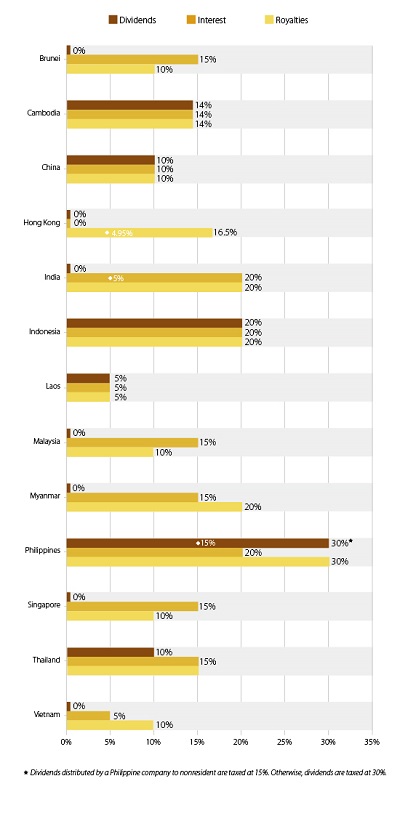A withholding tax is a tax that is kept back from an employee’s salary and subsequently paid directly to the government. Withholding taxes are commonly employed by countries throughout the world to help combat tax evasion.
Countries in Asia typically divide withholding tax into dividends, interest and royalties payments, with the amount of each varying considerably in each country. India, for instance, does not have any withholding tax on dividends, but has a 20 percent tax on royalties. Here, we provide a chart comparing the three withholding tax rates of China, India, Hong Kong, and the ten nations of ASEAN.
![]() Analysis of Asia’s Tax Rates, Part 1: Corporate Income Tax
Analysis of Asia’s Tax Rates, Part 1: Corporate Income Tax
Whilst the majority of these rates are fairly self-explanatory, there are several more nuanced withholding tax policies which should be explained. For example, while Hong Kong does not have a withholding tax on the income of either residents or non-residents, it has a small tax for royalty payments made to non-residents for the use of intangible assets in or outside of Hong Kong. Because the amount applicable for taxation is 30 percent of the gross amount of royalties paid, this results in a royalty tax rate of 4.95 percent. Furthermore, if the royalty payment is made to a non-resident for the use of intangible assets that were once owned by an entity in Hong Kong, 100 percent of the royalty is applicable for taxation, resulting in a 16.5 percent royalty tax rate.
In China, withholding tax payments for dividends, interest and royalties can all be affected by the country’s tax treaties. If the respective rate in a given tax treaty is higher than 10 percent, the 10 percent rate will be adopted; if the rate in the tax treaty is lower than 10 percent, the rate in the tax treaty will be adopted. For example, Hong Kong’s double tax agreement with China reduces the withholding tax rate on dividends from 10 percent to five percent. This means that China-sourced dividends remitted to HK are subject to a reduced withholding rate of five percent.
Singapore’s tax treaties also help to clarify the jurisdiction in which interest or royalties are deemed to arise. The source state will usually be the jurisdiction in which the payer of the interest or royalty is resident. In certain cases, both states will tax interest or royalty income, although at lower rates.
In Vietnam, employers must withhold the required percentage of their employees’ personal income and deposit the monthly amount with the State Treasury no later than the 20th day of the following month. Employers must also finalize PIT declarations on behalf of their employees at the end of the year provided the employee only has income from the employer, and authorizes their employer to make this tax finalization on their behalf.
Finally, India’s basic interest rate is 20 percent, but non-residents engaged in certain infrastructure businesses are liable for a five percent rate until July 2015.
 This article is an excerpt from the December issue of Asia Briefing Magazine, titled “The 2015 Asia Tax Comparator“. In this issue, we compare and contrast the most relevant tax laws applicable for businesses with a presence in Asia. We analyze the different tax rates of 13 jurisdictions in the region, including India, China, Hong Kong, and the 10 member states of ASEAN, which consists of Brunei, Cambodia, Indonesia, Laos, Malaysia, Myanmar, the Philippines, Singapore, Thailand and Vietnam. We also take a look at some of the most important compliance issues that businesses should be aware of, and conclude by discussing some of the most important tax and finance concerns companies will face when entering Asia. This article is an excerpt from the December issue of Asia Briefing Magazine, titled “The 2015 Asia Tax Comparator“. In this issue, we compare and contrast the most relevant tax laws applicable for businesses with a presence in Asia. We analyze the different tax rates of 13 jurisdictions in the region, including India, China, Hong Kong, and the 10 member states of ASEAN, which consists of Brunei, Cambodia, Indonesia, Laos, Malaysia, Myanmar, the Philippines, Singapore, Thailand and Vietnam. We also take a look at some of the most important compliance issues that businesses should be aware of, and conclude by discussing some of the most important tax and finance concerns companies will face when entering Asia. |
![]()
Manufacturing Hubs Across Emerging Asia
In this issue of Asia Briefing Magazine, we explore several of the region’s most competitive and promising manufacturing locales including India, Indonesia, Malaysia, Singapore, Thailand and Vietnam. Exploring a wide variety of factors such as key industries, investment regulations, and labor, shipping, and operational costs, we delineate the cost competitiveness and ease of investment in each while highlighting Indonesia, Vietnam and India’s exceptional potential as the manufacturing leaders of the future.
 The Gateway to ASEAN: Singapore Holding Companies
The Gateway to ASEAN: Singapore Holding Companies
In this issue of Asia Briefing Magazine, we highlight and explore Singapore’s position as a holding company location for outbound investment, most notably for companies seeking to enter ASEAN and other emerging markets in Asia. We explore the numerous FTAs, DTAs and tax incentive programs that make Singapore the preeminent destination for holding companies in Southeast Asia, in addition to the requirements and procedures foreign investors must follow to establish and incorporate a holding company.
 An Introduction to Tax Treaties Throughout Asia
An Introduction to Tax Treaties Throughout Asia
In this issue of Asia Briefing Magazine, we take a look at the various types of trade and tax treaties that exist between Asian nations. These include bilateral investment treaties, double tax treaties and free trade agreements – all of which directly affect businesses operating in Asia.




